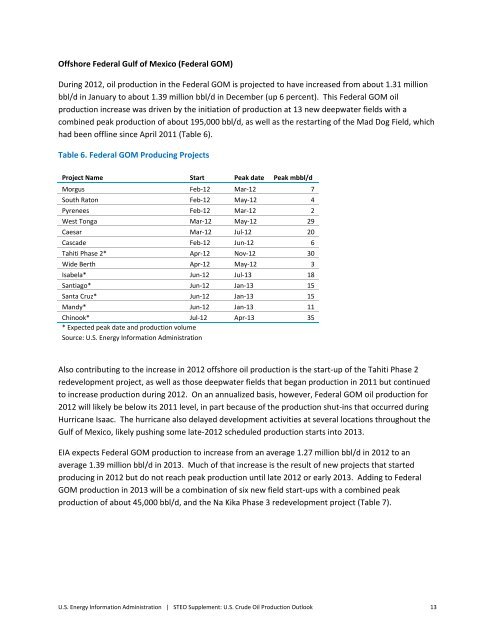Key drivers for EIA's short‐term US crude oil production outlook
Key drivers for EIA's short‐term US crude oil production outlook
Key drivers for EIA's short‐term US crude oil production outlook
Create successful ePaper yourself
Turn your PDF publications into a flip-book with our unique Google optimized e-Paper software.
Offshore Federal Gulf of Mexico (Federal GOM)<br />
During 2012, <strong>oil</strong> <strong>production</strong> in the Federal GOM is projected to have increased from about 1.31 million<br />
bbl/d in January to about 1.39 million bbl/d in December (up 6 percent). This Federal GOM <strong>oil</strong><br />
<strong>production</strong> increase was driven by the initiation of <strong>production</strong> at 13 new deepwater fields with a<br />
combined peak <strong>production</strong> of about 195,000 bbl/d, as well as the restarting of the Mad Dog Field, which<br />
had been offline since April 2011 (Table 6).<br />
Table 6. Federal GOM Producing Projects<br />
Project Name Start Peak date Peak mbbl/d<br />
Morgus Feb‐12 Mar‐12 7<br />
South Raton Feb‐12 May‐12 4<br />
Pyrenees Feb‐12 Mar‐12 2<br />
West Tonga Mar‐12 May‐12 29<br />
Caesar Mar‐12 Jul‐12 20<br />
Cascade Feb‐12 Jun‐12 6<br />
Tahiti Phase 2* Apr‐12 Nov‐12 30<br />
Wide Berth Apr‐12 May‐12 3<br />
Isabela* Jun‐12 Jul‐13 18<br />
Santiago* Jun‐12 Jan‐13 15<br />
Santa Cruz* Jun‐12 Jan‐13 15<br />
Mandy* Jun‐12 Jan‐13 11<br />
Chinook* Jul‐12 Apr‐13 35<br />
* Expected peak date and <strong>production</strong> volume<br />
Source: U.S. Energy In<strong>for</strong>mation Administration<br />
Also contributing to the increase in 2012 offshore <strong>oil</strong> <strong>production</strong> is the start‐up of the Tahiti Phase 2<br />
redevelopment project, as well as those deepwater fields that began <strong>production</strong> in 2011 but continued<br />
to increase <strong>production</strong> during 2012. On an annualized basis, however, Federal GOM <strong>oil</strong> <strong>production</strong> <strong>for</strong><br />
2012 will likely be below its 2011 level, in part because of the <strong>production</strong> shut‐ins that occurred during<br />
Hurricane Isaac. The hurricane also delayed development activities at several locations throughout the<br />
Gulf of Mexico, likely pushing some late‐2012 scheduled <strong>production</strong> starts into 2013.<br />
EIA expects Federal GOM <strong>production</strong> to increase from an average 1.27 million bbl/d in 2012 to an<br />
average 1.39 million bbl/d in 2013. Much of that increase is the result of new projects that started<br />
producing in 2012 but do not reach peak <strong>production</strong> until late 2012 or early 2013. Adding to Federal<br />
GOM <strong>production</strong> in 2013 will be a combination of six new field start‐ups with a combined peak<br />
<strong>production</strong> of about 45,000 bbl/d, and the Na Kika Phase 3 redevelopment project (Table 7).<br />
U.S. Energy In<strong>for</strong>mation Administration | STEO Supplement: U.S. Crude Oil Production Outlook 13
















